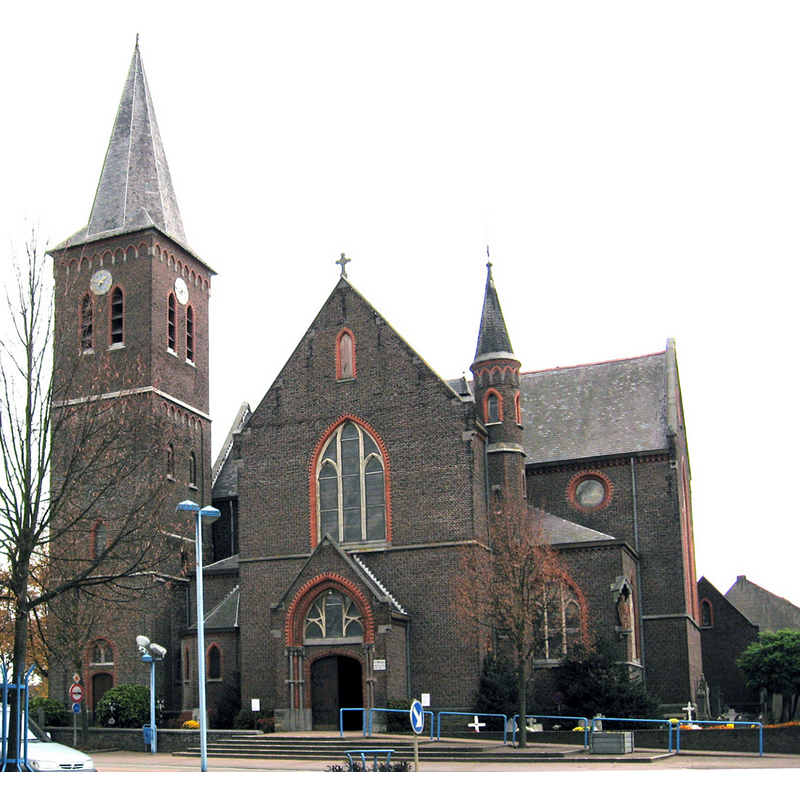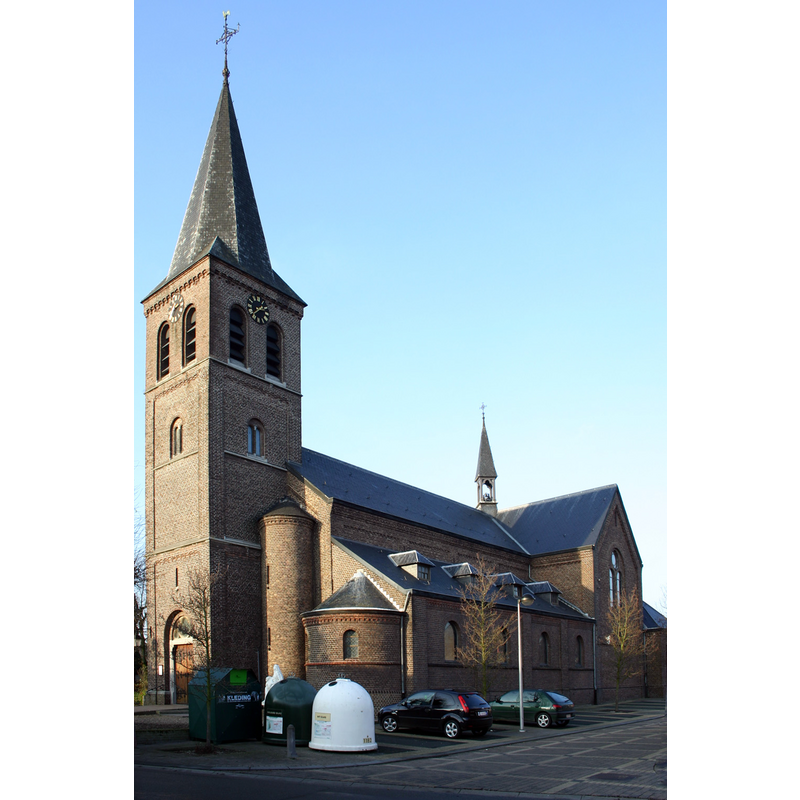Geistingen / Ophoven-Geistingen

Image copyright © Sonuwe, 2007
GFDL / CC-BY-SA-3.0
Results: 8 records
information
information
view of basin and cover
view of church exterior - churchyard - detail
view of church exterior - south view
Scene Description: Source caption: "Sint-Servatiuskerk in Ophoven"
Copyright Statement: Image copyright © Sonuwe, 2007
Image Source: edited detail of a digital photograph 4 November 2007 by Sonuwe [https://commons.wikimedia.org/wiki/File:Ophoven_-_Sint-Servatiuskerk.jpg] [accessed 8 September 2024]
Copyright Instructions: GFDL / CC-BY-SA-3.0
view of church exterior - southwest view
Scene Description: Source caption: "Kerk in Geistingen (Kinrooi, Belgium)"
Copyright Statement: Image copyright © Edelhart Kempeneers, 2006
Image Source: digital photograph 10 December 2006 by Edelhart Kempeneers [https://commons.wikimedia.org/wiki/File:Geistingen_-_Kerk.jpg] [accessed 8 September 2024]
Copyright Instructions: CC-BY-SA-2.5
view of font - fragment
view of font and cover in context
INFORMATION
FontID: 25679GEI
Object Type: Baptismal Font1 (fragment)
Church/Chapel: Parochiekerk Sint-Lambertus
Church Patron Saints: St. Lambert of Maastricht[aka Lambaert, Lambertus, Lambrecht, Landebertus]
Church Location: Vroenhof 3, Geistingen, 3640 Kinrooi, Belgium
Country Name: Belgium
Location: Limburg, Vlaanderen / Flandres
Directions to Site: Located off (E) road N78, 5-6 km N of Maaseik, in the submunicipality of Koonroi, near the Dutch border
Ecclesiastic Region: Hasselt Bistum
Font Location in Church: [cf. FontNotes]
Date: n.d.
Century and Period: Medieval
Credit and Acknowledgements: We are grateful to Pol Herman for bringing this fragment to our attention and for his help in documenting it.
Church Notes: parish of Geistingen documented 8thC
Font Notes:
Click to view
The entry for this church in the Onroerend Erfgoed [https://inventaris.onroerenderfgoed.be/erfgoedobjecten/73161] [accessed 8 September 2024]
reports a baptismal font of the mid-19th century in it : "Doopvont, hardsteen en messing (midden 19de eeuw)." The font at nearby Ophoven is also 19th-century.
A comunication to BSI from Pol Herman (e-mail of 19 August 2024) reports the fragment of a medivel font from Ophoven-Geistingen: "There is only one reference to the Romanesque font of Ophoven : "Orphoven-Geistingen door de eeuwen heen" (1966) by Jan Geerkens and reverend Donaat Snijders, page 229 [cf. ImagesArea]; on this page, the authors argue that the church of Geistingen is old, because of the presumed age of the preserved fragment of its baptismal font. They continue: "We know of a similar fragment from Ophoven, but much nicer. The beautiful fragment is 51 cm long and 33 cm high. It shows a dragon figure that is very gracefully chiselled. In our opinion, this is the representation of the evil spirit, as it often appears on Romanesque baptismal fonts." Today, adds Pol Herman, nobody seems to know the whereabouts of this fragment. Very little is known about the history of Ophoven and of its church. The name of Ophoven only appears in the 15th century. A church there dedicated to St. Servatius is mentioned in 1477. For this reason, I would be inclined to assume that the fragment should be linked to the church of nearby Geistingen, where a parish already existed in the 8th century. The present font at Ophoven is neo-gothic."
A follow-up communication by Pol Herman (e-mail of 23 August 2924) presents additional information on the fragment and its misadventures, although there may actually be two fragments, unless the two mentioned are one and the same: "There was already a parish and church in Geistingen in the 8th century. In the 18th century, mention was made of the dilapidated state of this building. In 1837, the demolition of the old church began and the construction of a new church started on the same site, partly recycling material from this church. However, during the works, part of the new church collapsed. The old church tower had fallen onto the new nave during a storm. Before the reconstruction could be continued, a dispute arose about the location of the new church. Jan Teuwen from Kinrooi, chairman of the churchwardenship, was in favour of a new location and on March 11, 1839, he donated a building plot of 8 acres in the village centre to the churchwardenship on condition that the new neo-Romanesque church would be built there. A chapel on the cemetery of Geistingen still indicates the location of the choir of the original church. The Romanesque baptismal font of Geistingen is mentioned in "Ophoven-Geistingen door de eeuwen heen" (1966 en 1967) by Jan Geerkens and reverend Donaat Snijders, page 229 [cf. supra]:"The font was discarded when the new church was built in 1839. The font broke and the largest fragment was discovered by J. Geerkens as part of the curbstones of the pavement in front of the farm 't Heufke. It is 56 cm long, 16 cm high and 14 cm wide. It has a concave shape without inscriptions." There exists a bad photo made by Donaat Snijders in 1964. On its back is written : "fragment of the Romanesque font of the church of Geistingen, that was demolished in 1901. Was a part of the pavement at 't Heufke of Leonardus Henckens. Geerkens has dug it up in 1961 with permission." However, the church was not demolished in 1901. Instead, in that year the building was thoroughly restored and enlarged by architect J. Tonnaer by adding a side aisle and a transept, and the choir was renewed. It is difficult to recognize the object in the picture as a Romanesque baptismal font. If it was, then it has been very badly damaged. Local historian Thieu Wieërs tells me another version : The stone fragment is probably a find by Jef Wieërs, who was born in Geistingen in 1888 and died in Kessel-Lo in 1970. He was my father's oldest cousin. He was a historian and emigrated to the Netherlands after WWI. He returned in his old age. From his youth he was fascinated by the history of our village. He had filled entire notebooks with his findings. Later, Snijders and Geerkens used his notebooks without mentioning him even once in their work. When I went to visit him as a young boy around 1960, he started telling me about that piece of stone. He urged me to go and look at the farm where his mother was born. So I did. I found a kind of scrap stone that stood against the corner of the house to prevent damage to the walls by cart wheels. So the object was not inserted between the stones that served as a pavement in front of the farm. The fragment became part of the heritage collection of amateur archaeologist Geerkens, which was sold off by his children after his death. They hated their father's hobby. The municipality bought what was left, but the most valuable objects had already disappeared."
COORDINATES
Church Latitude & Longitude Decimal: 51.13266, 5.80935
Church Latitude & Longitude DMS: 51° 7′ 57.58″ N, 5° 48′ 33.66″ E
UTM: 31U 696552 5668331
MEDIUM AND MEASUREMENTS
Material: stone
Font Shape: [fragment]
Notes on Measurements: [cf. FontNotes for the measurements of the fragment]
REFERENCES
Snijders, D., Ophoven en Geistingen door de eeuwen heen, 1966
![[cf. FontNotes]](/static-50478a99ec6f36a15d6234548c59f63da52304e5/others/permission_not_available.jpg)
